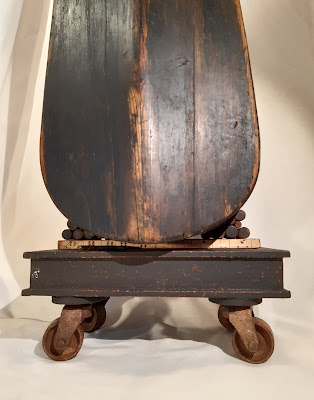I am so delighted to have won the Most Outstanding Work of the Immanuel Arts Festival 2022 in Buderim Sunshine Coast Australia ...
Postcard from B is all about music, time and a broken tryst ...
Starting with a rescued wooden violin case a friend gave me some time past - I have mounted the case on a platform to give it stability and set the platform on four rusty iron wheels - giving the piece a sense of travel - and then inside the case - well, I'll let you explore the story ...
The violin case is very old and quite beautiful and to keep a sense of its age and its history, I have not spent too much energy nor material patching-up the wear and tear of time ... it would be wonderful to know to whom it originally belonged and what beautiful music was played on the violin it protected ...
Scrolls made from aged piano sheet music from the turn of the century add stability and meaning ...
Open the case cover and an intricate story unfolds within ...
Staring at the bottom are many scrolls containing the music and the words from a bygone time ...
... then next is the workings of a clock from New York and dated 1882 -
the year our story begins ...
wind the spring up and the mechanism ticks the hours away ...
... next is our heroine ...
The centre ( central ) piece is a late 1800s postcard featuring a photo of Maud Jeffries ... I found this very personal discarded postcard at a Collectables Fair some time ago ...
Maud Evelyn
Craven Jeffries (14 December 1869 – 26 September 1946) was an American actress.
A popular subject for a wide range of theatrical post-cards and studio
photographs, she was noted for her height, voice, presence, graceful figure, attractive
features, expressive eyes, and beautiful face.
An audience
favourite wherever she went, Jeffries' performances over a decade in New York,
London, Australia, and New Zealand met wide critical acclaim; especially in the
role of Desdemona in Shakespeare's Othello and, in particular, for her creation
of the role of Mercia in Wilson Barrett's masterpiece The Sign of the Cross. On
viewing Jeffries' performance (when just 20) as Almida in Claudian, one critic
observed:
…” in Maud
Jeffries we have an almost ideal Almida. It is emphatically a part for a young
girl, and Miss Jeffries made it throb with life and genius. So youthful an actress
so capable of feeling, not merely interpreting emotion, ought to and will have
a future before her “…

Maud married
a wealthy Australian grazier, Boer war veteran, and former aide-de-camp to New
Zealand's Governor-General, James Bunbury Nott Osborne (1878-1934). Osborne was
so enamoured of Jeffries that he joined her theatrical company in late 1903 in
order to press his suit. Engaged in May 1904, they married in October 1904, and
had two children together (one of whom died as an infant). Jeffries left the
stage in 1906, and continued to live a quiet, very happy life, devoted to her
family and her beautifully designed gardens, on their family property,
"Bowylie", at Gundaroo, NSW, until her death, at 76 years, of cancer.
The reverse side of the postcard bears a very personal message ...
" Do not wait tonight going home at 12pm. Not too good today " ...
signed with the initials BG ( ? ) ... who is BG you ask ... maybe a lover
or maybe Maud herself using a coded name ...
The fob watch - another relic from the 1800's - has stopped at 2:30 -
a significant time maybe ???...
... and finally at the almost top of the story is another chamber ...
... the door opens to reveal a set of chimes in a golden box ...
chimes that announce the time, or chimes that announce someone at the door
or chimes that sound out a musical tune ...
... and at the apex of the story is a rosette ...
... end of my story - I trust you have your own interpretation ...
... life and love and mere existence are all so fragile ...
... case closed ...
















No comments:
Post a Comment
Note: Only a member of this blog may post a comment.